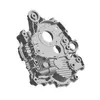Mobile:+86-311-808-126-83
Email:info@ydcastings.com
German
aluminum continuous casting
The Advancements in Aluminum Continuous Casting Technology
Aluminum continuous casting is an essential process in the aluminum industry, influencing the quality, efficiency, and sustainability of aluminum production. Unlike traditional casting methods that require multiple steps and significant amounts of energy, continuous casting has revolutionized the way aluminum is produced, making it faster, cheaper, and more efficient.
Understanding Continuous Casting
Continuous casting refers to a technique where molten metal is poured into a mold and solidifies as it is drawn out continuously. This method allows for the production of large lengths of aluminum slabs or billets, which can then be further processed into various products. Continuous casting can significantly reduce the production time and the overall energy consumption compared to traditional batch casting processes.
In the aluminum industry, continuous casting typically involves the use of a tundish, a pouring basin that supplies molten aluminum into a mold. As the aluminum solidifies, it is pulled through the mold continuously, which helps to maintain its temperature and quality throughout the process. The result is a product that has uniform properties and can be easily adapted for specific applications.
Benefits of Aluminum Continuous Casting
1. Cost Efficiency The continuous casting process is more economical than traditional methods. Since it allows for the production of large quantities of aluminum at one time, it reduces setup and operational costs associated with multiple melt cycles and casting operations.
2. Improved Quality Continuous casting minimizes the defects often associated with traditional casting. Due to the constant flow of molten metal and controlled cooling rates, products manufactured through continuous casting tend to have fewer inclusions and porosity issues, resulting in a higher-quality aluminum.
aluminum continuous casting

3. Sustainability In an era where sustainability is becoming increasingly important, continuous casting offers a greener alternative. The process is inherently energy efficient, requiring less energy than conventional methods. Furthermore, with a growing emphasis on recycling in the aluminum industry, continuous casting helps facilitate the use of recycled aluminum, reducing the environmental impact of production.
4. Versatility Continuous casting is versatile and can produce a wide range of aluminum products. From slabs used in the automotive and aerospace industries to specialized alloys for construction and electrical applications, the adaptability of this process supports various market needs.
Challenges and Innovations
Despite the numerous advantages, the aluminum continuous casting process is not without its challenges. Maintaining the quality of the molten metal and preventing oxidation are critical concerns. Any contamination can lead to defects in the final product. Innovations in technology are addressing these issues; for instance, the use of advanced sensors and automation systems can monitor and control temperature and composition in real-time, improving overall quality.
Recent advancements in materials and process technology are also making the continuous casting of aluminum alloys more feasible and efficient. Researchers are continually exploring new ways to enhance the process, including the development of better mold designs, improved cooling techniques, and more efficient pouring strategies that can help mitigate common issues like surface defects and dimensional inaccuracies.
Conclusion
Aluminum continuous casting represents a significant evolution in metal production, combining efficiency, quality, and sustainability. As the industry continues to grow and adapt to new challenges, ongoing innovations in continuous casting technology will play a crucial role in meeting the demands of an ever-changing global market. With its ability to produce high-quality aluminum products at lower costs and with reduced environmental impact, continuous casting is likely to remain at the forefront of aluminum manufacturing for years to come. By embracing these advancements, the aluminum industry can not only enhance productivity but also contribute positively to sustainable practices in manufacturing.
-
Superior Aluminum Castings in Automotive Engine PartsNewsAug.22,2025
-
Common Materials Used in Fan Housing ManufacturingNewsAug.22,2025
-
Symptoms of a Stuck Automobile Water Pump ImpellerNewsAug.22,2025
-
The Importance of Valve Castings in Water TreatmentNewsAug.22,2025
-
Welding Techniques for End Cap Stainless Steel FittingsNewsAug.22,2025
-
How to Install a Water Pump Connector ProperlyNewsAug.22,2025











